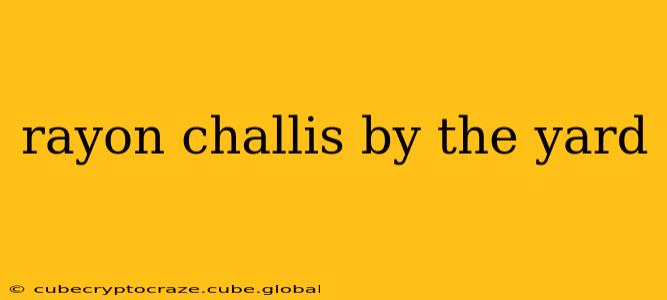Rayon challis has earned its place as a favorite among sewists and designers for its drape, softness, and versatility. This lightweight fabric, known for its fluid movement and subtle sheen, is perfect for a wide range of garments and projects. But what exactly is rayon challis, and what makes it so special? Let's dive in!
What is Rayon Challis Fabric?
Rayon challis is a woven fabric made from rayon fibers. Rayon itself is a semi-synthetic fiber, meaning it's manufactured from natural materials (typically cellulose from wood pulp) but processed into a fiber form. This process gives rayon its unique properties, resulting in a fabric that's both luxurious and surprisingly affordable compared to some natural alternatives like silk. The "challis" part refers to the fabric's weave structure, which creates its characteristic soft hand and delicate drape. It's typically a plain weave, giving it a smooth surface.
What are the Characteristics of Rayon Challis?
Rayon challis boasts several key qualities that make it a popular choice:
- Drape: It's exceptionally lightweight and drapes beautifully, flowing gracefully over the body. This makes it ideal for creating garments with soft, flowing silhouettes.
- Softness: The smooth, fine weave contributes to its incredibly soft hand feel, making it comfortable against the skin.
- Versatility: It's suitable for a variety of garments, from flowing skirts and dresses to blouses and scarves. It's also popular for linings.
- Print Quality: Rayon challis takes prints beautifully, displaying intricate designs with clarity and vibrancy.
- Affordable Luxury: While possessing the qualities of much more expensive fabrics, rayon challis remains relatively affordable, making it an accessible choice for various budgets.
What are the Pros and Cons of Rayon Challis?
Like any fabric, rayon challis has its advantages and disadvantages:
Pros:
- Beautiful drape and flow
- Soft and comfortable against the skin
- Versatile for various projects
- Affordable
- Excellent print quality
Cons:
- Can wrinkle easily: This requires careful handling and potentially ironing after washing.
- May be prone to shrinking: Pre-washing is highly recommended before cutting and sewing.
- Can be delicate: Needs gentle handling to prevent snags and tears.
How is Rayon Challis Fabric Used?
The versatility of rayon challis makes it suitable for many applications:
- Garments: Dresses, skirts, blouses, tops, scarves, and linings. Its lightweight nature makes it particularly suitable for warm weather clothing.
- Home Decor: Curtains, lightweight throws, and other home décor projects where a soft, flowing texture is desired.
What is the Best Way to Care for Rayon Challis?
Proper care will extend the lifespan of your rayon challis fabric:
- Washing: Hand washing in cool water with a gentle detergent is recommended. Avoid harsh chemicals.
- Drying: Air drying is preferable to prevent shrinkage and damage. Avoid machine drying.
- Ironing: Iron on a low setting, using a pressing cloth to protect the fabric's delicate surface.
How Does Rayon Challis Compare to Other Fabrics?
Rayon challis offers a unique combination of qualities that differentiate it from other fabrics:
- Compared to silk: Rayon challis provides a similar drape and luxurious feel but at a significantly lower cost. While not as durable as silk, it's a great alternative for those seeking a similar aesthetic without the high price tag.
- Compared to cotton: Rayon challis is softer and drapes better than cotton, but it may require more delicate care. Cotton is generally more durable.
- Compared to other rayons: While other rayon fabrics may offer similar softness, challis distinguishes itself with its distinct lightweight drape and fine weave.
Where Can I Buy Rayon Challis by the Yard?
Rayon challis is readily available from various online retailers and fabric stores. Many offer a wide selection of colors, prints, and weights.
Is Rayon Challis Easy to Sew?
Rayon challis is generally considered easy to sew, particularly for experienced sewers. Its lightweight nature allows for smooth feeding through the machine. However, its delicate nature means careful handling is needed to avoid snagging or stretching. Using a sharp needle and a walking foot can improve the sewing process.
This comprehensive guide provides a detailed overview of rayon challis, addressing its properties, uses, care instructions, and comparisons with other fabrics. With its versatility, affordability, and luxurious feel, rayon challis remains a beloved fabric for both novice and expert sewists alike.
